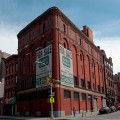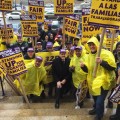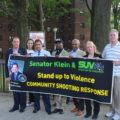The Bronx Is Up
Devastated for decades, the borough has roared back—but pockets of poverty remain.
Four decades ago, the Bronx was burning. Today the Bronx is boasting—of its new people, new jobs, and, believe it or not, trendy new restaurants. But the borough’s boom hasn’t done enough to ease one of the most pernicious problems of the bad old days: multigenerational government dependency.
By the middle of the twentieth century, the Bronx was already becoming synonymous with urban decline. As the middle class moved out, landlords began taking on more tenants from the city’s growing welfare population. The crime rate exploded. In 1967, the borough saw 141 murders. Just five years later, in 1972, 390 people were killed.
The Bronx’s recovery from this devastation began in the 1980s. Then-mayor Ed Koch could have surveyed those mostly empty blocks of the South Bronx and decided to leave them that way. Cities such as Detroit are doing that today, letting people tend to urban farms where they once had neighbors.
Instead, Koch—heavily encouraged by local pols and nonprofits—resolved to start over. As the city’s economy rebounded from the fiscal crisis, Koch invested $5 billion citywide to lend money to companies and people who wanted to rescue abandoned or near-abandoned property. The program didn’t just prevent decay; it reversed it.
No one would have moved back and stayed, though, had New York City not kept them much safer. Police and prosecutors attacked the gun scourge. Broken Windows policing allowed cops to stop criminals for small offenses—and take their guns before they could commit bigger ones. The Bronx has also prospered from being a part of New York City’s economy. Without New York, the Bronx would likely have suffered the same fate as the nation’s other postindustrial cities.
All these forces—lower crime, investment in housing and transit, and a flourishing city—have combined to create an encouraging picture. Between 1990 and 2013, the borough’s population grew by 17 percent—faster than the city’s overall 15 percent, and much faster than Brooklyn (5.2 percent) and Manhattan (5.8 percent).
A booming borough has created the inevitable gentrification backlash. Locals fear that their neighborhood will become like hipster-rich Williamsburg. Borough president Ruben Diaz understands these very real concerns but is more sanguine about the future—especially because he has a keen memory of the past.
Though Diaz, too, worries about the lack of housing for poorer and working-class people, he notes that “I played in rubble” as a child. “I lived in this borough when the average homicide rate was 600-plus a year. I’m honored and pleased to be . . . developing housing.” So far, he says, “all we’ve seen, and we have to keep it, is a benefit to the Bronx. We deserve good things as well.”
Rising crime could stall or reverse the borough’s improving fortunes. But poverty remains the Bronx’s most serious problem. The Bronx, with 17 percent of the city’s population, has a full quarter of its public-housing residents—102,384 people, or more than 7 percent of the borough’s population. When and if New York ever fixes its public-housing system—encouraging people to move up and out rather than stay in place, effectively forever—it will make a big dent in the Bronx’s chronic poverty.
As long as the city doesn’t return to the mistakes of an earlier era—above all, the mistake of giving up on the future—the borough has considerable cause for optimism.
To reverse the order of the old Broadway song, in New York, the battery is down and the Bronx is up.
Nicole Gelinas is the Searle Freedom Trust Fellow at the Manhattan Institute, a contributing editor of City Journal, and a columnist at the New York Post. This op-ed is excerpted from the City Journal Winter 2016 edition.

















Follow Us